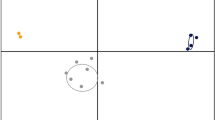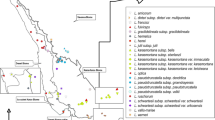Abstract
Allozyme variation at 11 loci (with 37 alleles) was studied electrophoretically in seven outbreeding, closely related diploid and tetraploid taxa, seven from sect.Leptogalium and two from sect.Leiogalium. Whereas the sections are clearly distinct by several different alleles, aggregates, species and subspecies differ only in the frequency or presence/absence of common alleles. The resulting dendrogram suggests phylogenetic relationships and is supported by other multidisciplinary evidence. Tetraploids have originated independently in several groups, and there is evidence for tetrasomic inheritance and thus for autopolyploidy in spite of normal meiotic bivalent pairing and partly suspected hybrid origin. Tetraploids differ from related diploids only little in number of alleles and expected heterozygosity within populations, but clearly exhibit higher numbers of genotypes. This often corresponds to their greater morphological variability, increased adaptive flexibility, and better colonizing capacity compared to related diploids.
Similar content being viewed by others
References
Ayala, F. J., Powell, J. R., Tracey, M. L., Mourao, C. A., Perez-Salas, S., 1972: Enzyme variability in theDrosophila willistoni group. IV. Genetic variation in natural populations ofDrosophila willistoni. — Genetics70: 113–139.
Brochmann, C., Soltis, D. E., Soltis, P. S., 1992: Electrophoretic relationships and phylogeny of nordic polyploids inDraba (Brassicaceae). — Pl. Syst. Evol.182: 35–70.
Cavalli-Molina, S., Motta, E. P. V., Schiengold, M., Winge, H., 1989: Identical isoenzyme patterns in sib plants ofRelbunium hypocarpium (Rubiaceae). — Rev. Brasil. Genet.12: 361–368.
Cai, Q., Macdonald, S. E., Chinnappa, C. C., 1990: Studies on theStellaria longipes complex (Caryophyllaceae): isozyme variability and the relationship betweenStellaria longipes andS. longifolia. — Pl. Syst. Evol.173: 129–141.
Crawford, D. J., 1983: Phylogenetic and systematic inferences from electrophoretic studies. — InTanksley, S. D., Orton, T. J., (Eds): Isoenzymes in plant genetics and breeding, pp. 257–287. — Amsterdam: Elsevier.
—, 1985: Electrophoretic data and plant speciation. — Syst. Bot.10: 405–416.
—, 1990: Enzyme electrophoresis and plant systematics. — InSoltis, D. E., Soltis, P. S., (Eds): Isozymes in plant biology, pp. 146–164. — London: Chapman & Hall.
—, 1984: Allozyme divergence and intraspecific variation inCoreopsis grandiflora (Compositae). — Syst. Bot.9: 219–225.
Desrochers, A. M., Bohm, B. A., 1995: Biosystematic study ofLasthenia californica (Asteraceae). — Syst. Bot.20: 65–84.
Ehrendorfer, F., 1949: Zur Phylogenie der GattungGalium I. Polyploidie und geographisch-ökologische Einheiten in der Gruppe desGalium pumilum Murray (Sect.Leptogalium Lange) im österreichischen Alpenraum. — Österr. Bot. Z.96: 109–138.
—, 1962: Cytotaxonomische Beiträge zur Genese der mitteleuropäischen Flora und Vegetation. — Ber. Deutsch. Bot. Ges.75: 137–152.
—, 1976:Rubiaceae, Galium. — InTutin, T. G., Heywood, V. H., Burges, N. A., Valentine, D. H., Walters, S. M., Webb, D. A., (Eds): Flora Europaea4: 14–36. — Cambridge: Cambridge University Press.
Hamrick, J. L., 1990: Isozymes and the analysis of genetic structure in plant populations. — InSoltis, D. E., Soltis, P. S., (Eds): Isozymes in plant biology, pp. 87–105. — London: Chapman & Hall.
—, 1989: Allozyme diversity in plant species. — InBrown, A. H. D., Clegg, M. T., Kahler, A. L., Weir, B. S., (Eds): Plant population genetics, breeding and genetic resources, pp. 43–63. — Sunderland, Ma.: Sinauer.
—, 1979: Relationships between life history characteristics and electrophoretically detectable genetic variation in plants. — Annu. Rev. Ecol. Syst.10: 173–200.
Harris, H., Hopkinson, D. A., 1976: Handbook of enzyme electrophoresis in human genetics. — Amsterdam: North-Holland.
Hauber, D. P., 1986: Autotetraploidy inHaplopappus spinulosus hybrids: evidence from natural and synthetic tetraploids. — Amer. J. Bot.73: 1595–1606.
Huber, W., Leuchtmann, A., 1992: Genetic differentiation of theErigeron species (Asteraceae) in the Alps: a case of unusual allozymic uniformity. — Pl. Syst. Evol.183: 1–16.
Hurka, H., 1993: Isozymes in population genetic studies. — InLieth, H., Al Masoom, A., (Eds): Towards the rational use of high salinity tolerant plants,2, pp. 75–82. — The Netherlands: Kluwer.
—, 1989: Aspartate aminotransferase isozyme in the genusCapsella (Brassicaceae): Subcellular location, gene duplication, and polymorphism. — Biochem. Gen.27: 77–90.
Jaaska, V., 1994: Isoenzyme evidence on the systematics ofHordeum sectionMarina (Poaceae). — Pl. Syst. Evol.191: 213–226.
Krendl, F., 1967: Cytotaxonomie derGalium mollugo-Gruppe in Mitteleuropas. — Österr. Bot. Z.114: 508–549.
—, 1993: Chromosomenzahlen und geographische Verbreitung in der GattungGalium (Sect.Leptogalium-Rubiaceae). — Biosyst. Ecol. Ser.4: 51–112. — Wien: Österr. Akad. Wiss.
Loveless, M. D., Hamrick, J. L., 1984: Ecological determinants of genetic structure in plant populations. — Annu. Rev. Ecol. Syst.15: 65–95.
Lowrey, T. K., Crawford, D. J., 1985: Allozyme divergence and evolution inTetramolopium (Compositae, Asteraceae) in the Hawaiian Islands. — Syst. Bot.10: 64–72.
Lumaret, R., 1985: Phenotypic and genotypic variation within and between populations of the polyploid complex,Dactylis glomerata L. — InHaeck, J., Woldendorp, J. W., (Eds): Structure and functioning of plant populations,2: phenotypic and genotypic variation in plant populations, pp. 343–353. — Amsterdam: North-Holland.
—, 1987: Mise en évidence d'un écotype de dactyle (Dactylis glomerata L.) de pelouses dolomitiques subalpines dans les Grisons (Suisse): origine et échanges géniques avec les dactyles des prairies adjacentes. — Ecol. Plant8: 3–20.
—, 1990: Phylogenetic relationships and gene flow between sympatric diploid and tetraploid plants ofDactylis glomerata (Gramineae). — Pl. Syst. Evol.169: 81–96.
Macdonald, S. E., Chinnappa, C. C., 1988: Patterns of variation in theStellaria longipes complex: Effects of polyploidy and natural selection. — Amer. J. Bot.75: 1191–2000.
Manen, J. F., Natali, A., Ehrendorfer, F., 1994: Phylogeny ofRubiaceae-Rubieae inferred from the sequence of a cpDNA intergene region. — Pl. Syst. Evol.190: 195–211.
Mcleod, M. J., Guttman, S. I., Eshbaugh, W. H., Rayle, R. E., 1983: An electrophoretic study of evolution inCapsicum (Solanaceae). — Evolution37: 562–574.
Meusel, H., Jäger, E. J., 1992: Vergleichende Chorologie der zentraleuropäischen Flora3. — Stuttgart: G. Fischer.
Natali, A., Manen, J. F., Ehrendorfer, F., 1995: Phylogeny of theRubiaceae-Rubioideae, in particular the tribeRubieae: evidence from a non-coding chloroplast DNA sequence. — Ann. Missouri Bot. Gard.82: 428–439.
Nei, M., 1972: Genetic distance between populations. — Amer. Nat.106: 283–292.
Pedrola-Monfort, J., Caujapé-Castells, J., 1994: Allozymic and morphological relationships amongAndrocymbium gramineum, A. europaeum, andA. psammophilum (Colchicaceae). — Pl. Syst. Evol.191: 111–126.
Qiu, Y. L., Parks, C. R., 1994: Disparity of allozyme variation level in threeMagnolia (Magnoliaceae) species from the southeastern United States. — Amer. J. Bot.81: 1300–1308.
Raelson, J. V., Grant, W. F., 1988: Evaluation of hypotheses concerning the origin ofLotus corniculatus (Fabaceae) using isoenzyme data. — Theor. Appl. Genet.76: 267–276.
Samuel, R., Pinsker, W., Ehrendorfer, F., 1990: Allozyme polymorphism in diploid and polyploid populations ofGalium. — Heredity65: 369–378.
—, 1995: Electrophoretic analysis of genetic variation within and between populations ofQuercus cerris, Q. pubescens, Q. petraea andQ. robur (Fagaceae) from eastern Austria. — Bot. Acta108: 290–299.
Shore, J. S., 1991: Tetrasomic inheritance and isozyme variation inTurnera ulmifolia vars.elegans Urb. andintermedia Urb. (Turneraceae). — Heredity66: 305–312.
Šipošová, H., 1987: A taxonomic-chorological study of theGalium pumilum Murray s.l. in Slovakia. — Acta Bot. Slov., ser. A. Tax. Geobot.10: 97–169.
Sneath, P. H. A., Sokal, R. R., 1973: Numerical taxonomy. — San Francisco: Freeman.
Soltis, D. E., Soltis, P. S., 1988: Electrophoretic evidence for tetrasomic segregation inTolmiea menziesii (Saxifragaceae). — Heredity60: 375–382.
—, 1990: Isoenzymes in plant biology. — London: Chapman & Hall.
—, 1993: Molecular data and the dynamic nature of polyploidy. — Crit. Rev. Pl. Sc.12: 243–273.
Wells, T. C., Bohm, B. A., 1994: Isozyme variation in North AmericanMenziesia (Ericaceae). — Syst. Bot.19: 407–423.
Wilson, H. D., Barber, S. C., Walter, T., 1983: Loss of duplicate gene expression in tetraploidChenopodium. — Biochem. Syst. Ecol.11: 7–13.
Author information
Authors and Affiliations
Rights and permissions
About this article
Cite this article
Ehrendorfer, F., Samuel, R. & Pinsker, W. Enzyme analysis of genetic variation and relationships in diploid and polyploid taxa ofGalium (Rubiaceae). Pl Syst Evol 202, 121–135 (1996). https://doi.org/10.1007/BF00985821
Received:
Revised:
Accepted:
Issue Date:
DOI: https://doi.org/10.1007/BF00985821




